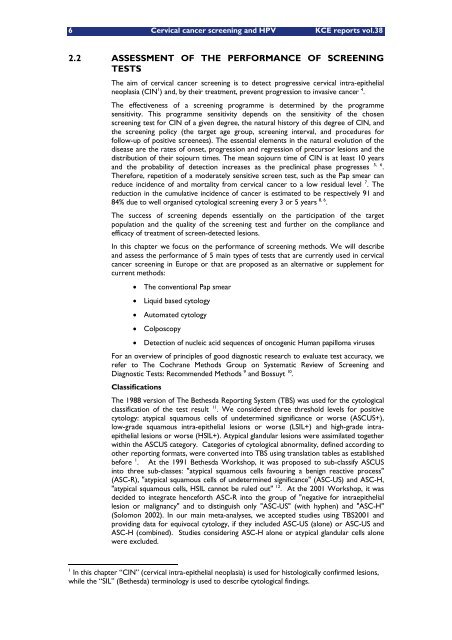Cervical Cancer Screening and Human Papillomavirus (HPV ... - KCE
Cervical Cancer Screening and Human Papillomavirus (HPV ... - KCE
Cervical Cancer Screening and Human Papillomavirus (HPV ... - KCE
Create successful ePaper yourself
Turn your PDF publications into a flip-book with our unique Google optimized e-Paper software.
6 <strong>Cervical</strong> cancer screening <strong>and</strong> <strong>HPV</strong> <strong>KCE</strong> reports vol.38<br />
2.2 ASSESSMENT OF THE PERFORMANCE OF SCREENING<br />
TESTS<br />
The aim of cervical cancer screening is to detect progressive cervical intra-epithelial<br />
neoplasia (CIN 1 ) <strong>and</strong>, by their treatment, prevent progression to invasive cancer 4 .<br />
The effectiveness of a screening programme is determined by the programme<br />
sensitivity. This programme sensitivity depends on the sensitivity of the chosen<br />
screening test for CIN of a given degree, the natural history of this degree of CIN, <strong>and</strong><br />
the screening policy (the target age group, screening interval, <strong>and</strong> procedures for<br />
follow-up of positive screenees). The essential elements in the natural evolution of the<br />
disease are the rates of onset, progression <strong>and</strong> regression of precursor lesions <strong>and</strong> the<br />
distribution of their sojourn times. The mean sojourn time of CIN is at least 10 years<br />
<strong>and</strong> the probability of detection increases as the preclinical phase progresses 5, 6 .<br />
Therefore, repetition of a moderately sensitive screen test, such as the Pap smear can<br />
reduce incidence of <strong>and</strong> mortality from cervical cancer to a low residual level 7 . The<br />
reduction in the cumulative incidence of cancer is estimated to be respectively 91 <strong>and</strong><br />
84% due to well organised cytological screening every 3 or 5 years 8, 6 .<br />
The success of screening depends essentially on the participation of the target<br />
population <strong>and</strong> the quality of the screening test <strong>and</strong> further on the compliance <strong>and</strong><br />
efficacy of treatment of screen-detected lesions.<br />
In this chapter we focus on the performance of screening methods. We will describe<br />
<strong>and</strong> assess the performance of 5 main types of tests that are currently used in cervical<br />
cancer screening in Europe or that are proposed as an alternative or supplement for<br />
current methods:<br />
The conventional Pap smear<br />
Liquid based cytology<br />
Automated cytology<br />
Colposcopy<br />
Detection of nucleic acid sequences of oncogenic <strong>Human</strong> papilloma viruses<br />
For an overview of principles of good diagnostic research to evaluate test accuracy, we<br />
refer to The Cochrane Methods Group on Systematic Review of <strong>Screening</strong> <strong>and</strong><br />
Diagnostic Tests: Recommended Methods 9 <strong>and</strong> Bossuyt 10 .<br />
Classifications<br />
The 1988 version of The Bethesda Reporting System (TBS) was used for the cytological<br />
classification of the test result 11 . We considered three threshold levels for positive<br />
cytology: atypical squamous cells of undetermined significance or worse (ASCUS+),<br />
low-grade squamous intra-epithelial lesions or worse (LSIL+) <strong>and</strong> high-grade intraepithelial<br />
lesions or worse (HSIL+). Atypical gl<strong>and</strong>ular lesions were assimilated together<br />
within the ASCUS category. Categories of cytological abnormality, defined according to<br />
other reporting formats, were converted into TBS using translation tables as established<br />
before 1 . At the 1991 Bethesda Workshop, it was proposed to sub-classify ASCUS<br />
into three sub-classes: "atypical squamous cells favouring a benign reactive process"<br />
(ASC-R), "atypical squamous cells of undetermined significance" (ASC-US) <strong>and</strong> ASC-H,<br />
"atypical squamous cells, HSIL cannot be ruled out" 12 . At the 2001 Workshop, it was<br />
decided to integrate henceforth ASC-R into the group of "negative for intraepithelial<br />
lesion or malignancy" <strong>and</strong> to distinguish only "ASC-US" (with hyphen) <strong>and</strong> "ASC-H"<br />
(Solomon 2002). In our main meta-analyses, we accepted studies using TBS2001 <strong>and</strong><br />
providing data for equivocal cytology, if they included ASC-US (alone) or ASC-US <strong>and</strong><br />
ASC-H (combined). Studies considering ASC-H alone or atypical gl<strong>and</strong>ular cells alone<br />
were excluded.<br />
1 In this chapter CIN (cervical intra-epithelial neoplasia) is used for histologically confirmed lesions,<br />
while the SIL (Bethesda) terminology is used to describe cytological findings.

















